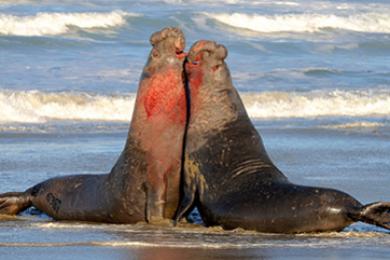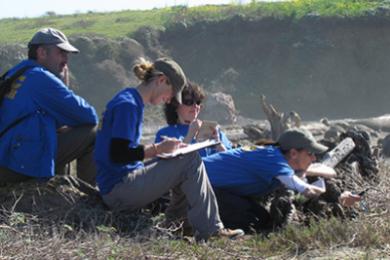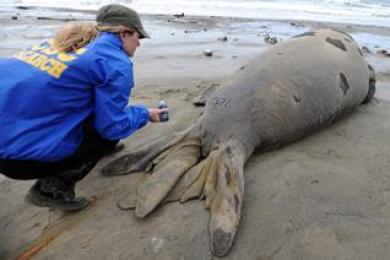Scientific research here is conducted through UCSC by faculty, students and visiting scholars authorized by an agreement with California State Parks. Current UCSC projects focus on elephant seals, sea lions, great white sharks and Steller sea lions. All elephant seal research projects at the Año Nuevo Reserve are overseen by UC Santa Cruz professor Dan Costa.
For over 40 years, the reserve has hosted groundbreaking studies on marine mammal behavior and this year is no exception. One of the most exciting and enlightening current projects focuses on the Bioacoustics—the study of how living things use sound and acoustical perceptions to shape behavior—of elephant seal bulls. If you’ve been out to see the elephant seals at Año Nuevo during the breeding season from December through March you have heard the loud and unforgettable vocalizations of the big males. Researchers were eager to understand more about why the bulls do this and what impact it has.
During the breeding season male elephant seals compete fiercely to establish their social status and thereby gain access to breeding females. Initial confrontations consist of ritualized displays involving loud vocalizations, physical posturing and only if necessary, fights. During this long period, adult males are without access to food or water and may lose as much as a third of their body mass. This makes energy conservation necessary.
The UCSC Bioacoustic field team is led by graduate student Caroline Casey. Over the course of four breeding seasons, the study required enormous effort to record and mark all the males in the colony, observe their interactions, obtain recordings free of background noise, and conduct playback experiments within the large, dynamic colony.
Acoustical analysis of each recorded voice and the creation of digital images allowed each male to be compared to his peers. "Anybody who's studied elephant seals knows that their vocal communications are important, but we haven't known what information is encoded in the vocalizations," Casey said.
"What we found is that these calls are identity signals. Each male has a unique call, and they learn to recognize the calls of their competitors, so they know how to respond during contests."
When they recognize the call of another male, they know whether to attack or flee depending on their previous interaction. A male who has lost a fight to another male will even flee from a playback of a recording of the victorious male's call.
This year (2018), the research continues as researchers attempt to discern whether this memory and response persists from year to year. In the future, the researchers hope to turn some of their attention to the vocalizations of females and their pups. So stay tuned for more groundbreaking research out of Año Nuevo....
Photographs and images are used with permission. This information comes from UCSC Research material.
Please click here to see Caroline and a pair of bulls at Año Nuevo: https://www.youtube.com/watch?v=FpIf6mPZJGA
The University of California Natural Reserve System’s sites encompass more than 756,000 acres, making it the largest university-administered reserve system in the world. “The mission of the Natural Reserve System is to contribute to the understanding and wise management of the Earth and its natural systems by supporting university-level teaching, research, and public service at protected natural areas throughout California.” https://naturalreserves.ucsc.edu/about-uc-reserves/index.html
Additional links that we can recommend are:
- The Ano Nuevo Reserve website: https://anonuevoreserve.ucsc.edu/
- Direct link to all research publications from Ano Nuevo: https://anonuevoreserve.ucsc.edu/research/index.html
- Fun research updates from Ano Nuevo Reserve: https://www.facebook.com/anonuevoresearch/
- Video showing how to mark an elephant seal with hair dye: https://www.youtube.com/watch?v=-xqqu7XQwNo



